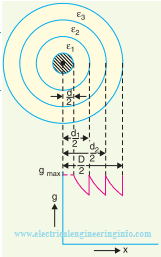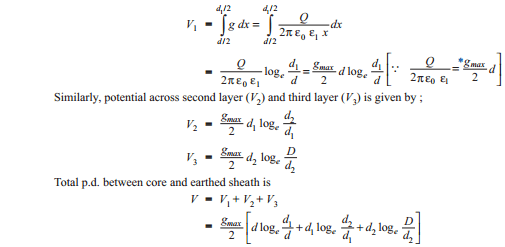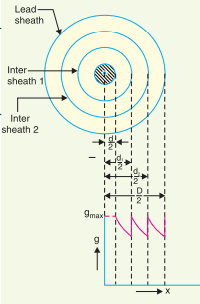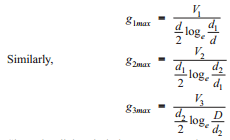Grading of cables:
Here I am going to explain the grading of underground cables. First before getting into the topic let us know what is grading of cables. It means the process of achieving uniform electrostatic stress in the dielectric of cables. It has already been shown that electrostatic stress in a single core cable has a maximum value (gmax) at the conductor surface and goes on decreasing as we move towards the sheath.
The maximum voltage that can be safely applied to a cable depends upon gmax i.e., electrostatic stress at the conductor surface. For safe working of a cable having homogeneous dielectric, the strength of dielectric must be more than gmax. If a dielectric of high strength is used for a cable, it is used only near the conductor where stress is maximum. But as we move away from the conductor, the electrostatic stress decreases so the dielectric will be unnecessarily overstrong.
The unequal stress distribution in a cable is undesirable for two reasons. Firstly, insulation of greater thickness is required which increases the cable size. Secondly, it may lead to the breakdown of insulation. In order to overcome the above disadvantages, it is necessary to have a uniform stress distribution in cables. This can be achieved by distributing the stress in such a way that its value is increased in the outer layers of dielectric. This is known as grading of cables.
Must Read:
This textbook “Principles of Power System by V.K Mehta” is the best in industry. Grab it now for very less price.
Methods of grading of cables :
(i) Capacitance grading
(ii) Intersheath grading
(i) Capacitance grading :
The process of achieving uniformity in the dielectric stress by using layers of different dielectrics is known as capacitance grading.In capacitance grading, the homogeneous dielectric is replaced by a composite dielectric.The composite dielectric consists of various layers of different dielectrics in such a manner that relative permittivity εr of any layer is inversely proportional to its distance from the centre.
Under such conditions, the value of potential gradient at any point in the dielectric is constant and is independent of its distance from the centre.In other words, the dielectric stress in the cable is same everywhere and the grading is ideal one. However, ideal grading requires the use of an infinite number of dielectrics which is an impossible task.In practice, two or three dielectrics are used in the decreasing order of permittivity; the dielectric of highest permittivity being used near the core.
The capacitance grading can be explained beautifully and derived by referring to the figure below There are three dielectrics of outer diameter d1, d2 and D and of relative permittivity ε1, ε2and ε3 respectively.If the permittivities are such that ε1 > ε2 > ε3 and the three dielectrics are worked at the same maximum stress, then,
Potential difference across the inner layer is
If the cable had homogeneous dielectric, then, for the same values of d, D and gmax , the permissible potential difference between core and earthed sheath would have been
Obviously, V > V′ i.e., for given dimensions of the cable, a graded cable can be worked at a greater potential than non-graded cable.Alternatively, for the same safe potential, the size of graded cable will be less than that of non-graded cable.The following points may be noted :
(i) As the permissible values of gmax are peak values, therefore, all the voltages in above expressions should be taken as peak values and not the r.m.s. values.
(ii) If the maximum stress in the three dielectrics is not the same, then,
Disadvantages of Capacitance grading method:
The principal disadvantage of Capacitance grading method is that there are a few high-grade dielectrics of reasonable cost whose permittivities vary over the required range.
This textbook “Principles of Power System by V.K Mehta” is the best in industry. Grab it now for very less price.
(ii) Intersheath grading :
In this method of Intersheath Grading, a homogeneous dielectric is used, but it is divided into various layers by placing metallic intersheaths between the core and lead sheath.The intersheaths are held at suitable potentials which are in between the core potential and earth potential.This arrangement improves voltage distribution in the dielectric of the cable and consequently more uniform potential gradient is obtained.
Consider a cable of core diameter d and outer lead sheath of diameter D.Suppose that two intersheaths of diameters d1 and d2 are inserted into the homogeneous dielectric and maintained at some fixed potentials.Let V1, V2 and V3 respectively be the voltage between the core and intersheath 1, between intersheath 1 and 2 and between intersheath 2 and outer lead sheath.As there is a definite potential difference between the inner and outer layers of each intersheath, therefore, each sheath can be treated like a homogeneous single core cable.
Must Read:
Maximum stress between the core and intersheath 1 is
Since the dielectric is homogeneous, the maximum stress in each layer is the same i.e.,
As the cable behaves like three capacitors in series, therefore, all the potentials are in phase i.e. Voltage between the conductor and earthed lead sheath is
V = V1+ V2+ V3
Disadvantages of Intersheath grading:
Intersheath grading has three principal disadvantages.
- Firstly, there are complications in fixing the sheath potentials.
- Secondly, the intersheaths are likely to be damaged during transportation and installation which might result in local concentrations of potential gradient.
- Thirdly, there are considerable losses in the intersheaths due to charging currents. For these reasons, intersheath grading is rarely used.





